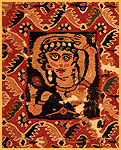|
Textile production in the Early
Byzantine period
The high-quality Byzantine textile was made of
silk, which in the Early  Byzantine
period was imported in its raw state from the Far East to
be made into cloth in state-controled Byzantine workshops.
Textile production is documented in cities such as Constantinople,
Alexandria, Tyr and Sidon. According to
Prokopios, a
pair of monks smuggled the first silkworm eggs into the empire
around 553-554, thus making supplies more secure, although
both raw silk and made-up cloth continued to be imported.
Byzantine silk was decorated with woven geometric patterns,
animals, birds and floral motifs. Precious and easily portable
as it was, it made an ideal diplomatic gift to send with embassies
to the West, where some of it was used to wrap the relics
or bodies of saints, clerics and kings. Early Byzantine textile
production is further illustrated by the linens and wools
of Coptic Egypt. Strips and patches with woven decoration
using a range of geometric motifs, schematized plants, animals
and humans, were sewn onto larger pieces of plain cloth which
were used as hangings or to make clothing. Large colourful
tapestries display both secular and religious - pagan or Christian
- imagery. Byzantine
period was imported in its raw state from the Far East to
be made into cloth in state-controled Byzantine workshops.
Textile production is documented in cities such as Constantinople,
Alexandria, Tyr and Sidon. According to
Prokopios, a
pair of monks smuggled the first silkworm eggs into the empire
around 553-554, thus making supplies more secure, although
both raw silk and made-up cloth continued to be imported.
Byzantine silk was decorated with woven geometric patterns,
animals, birds and floral motifs. Precious and easily portable
as it was, it made an ideal diplomatic gift to send with embassies
to the West, where some of it was used to wrap the relics
or bodies of saints, clerics and kings. Early Byzantine textile
production is further illustrated by the linens and wools
of Coptic Egypt. Strips and patches with woven decoration
using a range of geometric motifs, schematized plants, animals
and humans, were sewn onto larger pieces of plain cloth which
were used as hangings or to make clothing. Large colourful
tapestries display both secular and religious - pagan or Christian
- imagery.
|